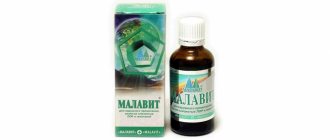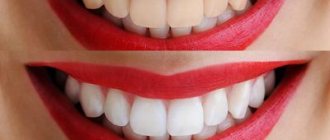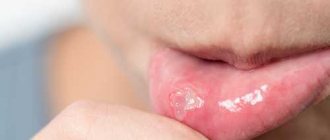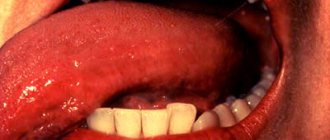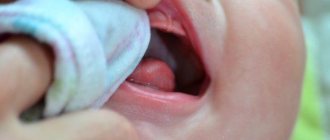Stomatitis can be recognized by multiple ulcers on the gums, tongue, palate, inner cheeks and lips. It all starts with redness, which is accompanied by a burning sensation or a slight tingling sensation, and only after that, in places where pathogens are most concentrated, an ulcer forms. As a rule, it is shallow, and nevertheless, at the slightest irritation - while eating or brushing teeth - it makes itself felt with severe pain. But don’t despair; with proper treatment, stomatitis can be defeated in 4-5 days. Chlorhexidine for stomatitis is one of the mouth rinses recommended by all doctors.
Where do bacteria come from in the mouth and how to fight them?
Whatever the type of stomatitis (and there are quite a few varieties of it - aphthous, allergic, herpetic, ulcerative), it is always accompanied by the active proliferation of bacteria or viruses on the mucous membrane. Do you think they come from outside, from dirty hands and unwashed fruit? But it turns out that even an absolutely healthy person’s mouth is always full of spirochetes, fungi, staphylococci, streptococci and other “cocci.” These cultures constantly interact and restrain the excessive development of one of their friendly company. This balance is also maintained by saliva, which allows the microflora to exist more or less normally, but not to multiply too actively. This is the normal microflora of the oral cavity, the task of which is to destroy “foreign” bacteria that enter the mouth from the outside.
And then overnight the balance of microorganisms is disrupted. There are too many of some, too few of others. This is stomatitis. It is not difficult to destroy harmony. This can be caused by many factors and is not always due to dirty hands or unwashed food. Inflammation of the mucous membrane can occur due to:
- colds;
- stress;
- injuries;
- taking antibiotics;
- hormonal surge;
- dehydration of the body, and, consequently, a significant decrease in the amount of saliva.
The presence of hard-to-reach places in the mouth that are difficult to penetrate with a toothbrush also significantly increases the risk of developing stomatitis. Carious cavities, gum pockets, leaky crowns - all these are ideal conditions for bacteria. You can’t get them there, so they begin to multiply beyond measure. The more tartar and plaque in your mouth, the higher the likelihood that you will sooner or later face the need to treat painful ulcers.
Precisely because with stomatitis you have to “tame” overly active bacteria, one of the mandatory components of treatment is an antiseptic. It doesn't have to be chlorhexidine. But since it is the most accessible and cheap, most often patients prefer to rinse their mouths with it. The essence of its action is simple: it penetrates inside the bacterial cell and prevents it from consuming oxygen, which naturally causes it to die immediately.
Which chlorhexidine to buy and how to prepare the solution?
Chlorhexidine is an aqueous solution of chlorhexidine digluconate. When you go to the pharmacy, you can see containers with different numbers on the label - 0.05%, 0.1%, 1%, 5% and 20%. They indicate the concentration of the active substance in the solution. For mouth and throat rinses, 0.05% chlorhexidine is always used. If you buy just this one, then you won’t need to breed anything. But if you have a 20% solution on hand, that’s not a problem either. 2 milliliters of concentrated solution per liter of warm boiled water - that’s 0.05% chlorhexidine.
Note! There is also an alcohol solution of chlorhexidine on sale, but under no circumstances should you rinse your mouth with it. This is a technical antiseptic that is most often used to disinfect medical instruments and hospital premises.
Interestingly, chlorhexidine bigluconate can be sold under different names. For example, dentists often prescribe Corsodil to their patients. This is the same solution, only produced and packaged abroad. Because of this, its price is exactly 10 times higher than its domestic analogue! Does this mean that with its help it will be possible to deal with bacteria faster and more effectively? Not at all.
Properties of chlorhexidine
Chlorhexidine (another name for chlorhexidine bigluconate) is an antiseptic drug. The product has the following properties (topically):
Why does stomatitis occur?
Stomatitis is an inflammatory disease in which characteristic ulcers form on the oral mucosa.
A person feels a burning sensation and pain, which significantly intensifies when talking, eating food and drinks, etc.
For young children, stomatitis poses a significant threat, since the child refuses food and the general condition is impaired: weakness, elevated body temperature and other signs of intoxication may be present.
There are many reasons why the body can develop such a disease, however, the main provoking factors are viruses and bacteria. They can penetrate from the outside or develop against the background of exposure to unfavorable factors.
Stomatitis often appears after burns and injuries to the oral cavity, as well as with dental problems.
Sometimes the disease occurs for no apparent reason, this is due to the fact that in the body of any person there are both beneficial and dangerous bacteria. The latter, as a rule, “sleep”. Stress, colds, surgery and other similar phenomena can cause active growth of harmful flora, so stomatitis often occurs after influenza, ARVI and other infections.
In children, pathology occurs, as a rule, due to the habit of putting everything in their mouth.
Is it possible to rinse your mouth with Chlorhexidine for stomatitis?
Chlorhexidine is an antiseptic with a pronounced bactericidal effect and intended for local external use.
Active regarding:
- streptococci;
- staphylococci;
- coli;
- Proteus;
- Klebsiella
And a number of other pathogenic microorganisms.
Since Chlorhexidine is able to quickly and effectively destroy harmful flora, the use of an antiseptic is completely justified.
Chlorhexidine is one of the most prescribed mouthwashes for stomatitis. The beneficial effect is noticeable after the first procedure. The general course of treatment is from 3 to 5 days.
One of the main advantages of the drug is that the active substances are not absorbed into the bloodstream.
Analogues of the product
There are a large number of antiseptic drugs on the pharmaceutical market.
The most popular of them:
| Chlorhexidine | Miramistin | Iodinol | Holisal | |
| Active substance | Chlorhexidine bigluconate | Miramistin | Iodine | Choline salicylate Cetalkonium chloride |
| Release form | Solution, spray, gel | Solution | Solution | Gel |
| Action | Antiseptic | Antiseptic | Antiseptic | Antiseptic, anti-inflammatory and analgesic |
| Activity against herpes | Not active | Active | Not active | Not active |
| Irritant effect | Virtually absent | Absent | Expressed | Possible short-term burning sensation, passes quickly |
| Use in children | Allowed | Allowed | Does not apply up to 5 years | Not recommended under 1 year of age |
| Price | 4-50 rub. | 180-250 rub. | 15-50 rub. | 360-500 rub. |
The choice of drug depends on the cause of occurrence, the severity of the clinical picture and the age of the patient. Iodinol and Cholisal require more targeted application of the product to the damaged area, which makes treatment difficult for extensive lesions.
Chlorhexidine and Miramistin have a wide spectrum of antimicrobial activity. Due to their liquid form and lack of irritation, they are effective treatments for stomatitis of various etiologies.
How to dilute a mouth rinse solution
In the pharmacy you can find the drug with a concentration: from 0.05% to 20%, such implementation is due to different therapeutic purposes and indications. For rinsing the mouth and throat, it is optimal to use a solution with a concentration of the active substance of 0.05%.
There is no need to dilute anything with water here.
In other cases, the drug is diluted with water, based on its concentration according to the instructions or recommendation of the doctor.
There are foreign analogues of the drug on sale that cost 10 or more times more. Their use is absolutely unjustified, since they are based on the same chlorhexidine digluconate, which means the effectiveness is the same at a significantly different cost.
Therapy process
Chlorhexidine is available in various forms:
- aqueous and alcohol solution;
- gel;
- spray;
- cream;
- suppositories;
- patch.
In the pharmacy you can find containers with different designations - 0.05%, 0.01%, 0.1%, 1%, 5% and 20%. These numbers indicate the concentration level of the active substance in the solution.
For stomatitis, the liquid form of Chlorhexidine is most often used. Sometimes a spray and gel are used.
Depending on the form and severity of the disease, the course and dosage of the medicine is selected.
If this is a bacterial form of stomatitis, then an aqueous or alcoholic solution of Chlorhexidine in a 0.01% concentration is prescribed to rinse the mouth. For a complete cure, it is necessary to use solutions in which the active substance has a higher concentration. For therapeutic rinsing, medication at room temperature is suitable, and you should rinse the mouth for at least a minute.
When treating candidal stomatitis, the solution is used in a concentration of 0.05%. The drug should be at room temperature, and the procedure itself is recommended to take 8-10 minutes.
Doctors consider Chlorhexidine a universal medicine in the fight against stomatitis. The main goal is to determine the form of the disease and select the required concentration. In addition, the therapeutic effect continues after the rinsing procedure is completed.
There are basic oral care recommendations before rinsing your mouth with Chlorhexidine:
- before rinsing, you should carry out maximum hygienic cleaning in your mouth: remove food debris in the spaces between the teeth using a flosser, brush and other interdental products;
- then you need to rinse your mouth with boiled water, then you can treat with medicine.
We suggest you read: How to treat stomatitis during pregnancy After completing the procedure, you need to refuse food for about a couple of hours. If pain in the oral cavity does not bother you too much, then two rinses a day are more than enough. In case of severe discomfort, the number of procedures should be increased to 3-4.
A universal remedy for treating the oral cavity are such traditional medicines as Iodinol, methylene blue, and potassium permanganate. Chlorhexidine can be used doubly effectively along with them, as well as with folk remedies - soda and herbs (oak bark, sage, chamomile).
How to rinse your mouth with Chlorhexidine for stomatitis in children and adults
Instructions for use for stomatitis:
- brush your teeth;
- rinse your mouth with warm boiled water;
- Take about 15 ml of solution into your mouth, hold for about 1-2 minutes, making rinsing movements, spit it out.
For moderate and severe stomatitis, repeat every 2-3 hours until the unpleasant symptoms completely disappear (usually this takes about 5-7 days).
If the disease does not cause severe discomfort and pain, you can limit yourself to two or three rinses per day. Chlorhexidine creates a protective film on the mucous membrane that lasts for several hours, so relief is noted immediately.
The above instructions apply to the finished solution when used in adults. Ingestion of even a small amount of the drug can cause unpleasant health consequences, so parents should approach the treatment of stomatitis in children with Chlorhexidine as responsibly as possible.
Features of the use of the drug depend on age. Those who already know how to rinse their mouth can use Chlorhexidine in the same way as described above. Young children are recommended to purchase a special spray for irrigation - it costs several times more, but it minimizes the risk of accidentally swallowing the medicine. In addition, this form is more convenient to use.
- For children, instead of a spray, you can use a cotton swab soaked in a solution (0.05%) - you will have to treat the oral cavity at least 3-4 times a day.
- After the oral cavity treatment procedure, you must refrain from eating and drinking for at least one hour (preferably several).
- You should not use the drug for more than 10 days in a row - this can lead to serious disruption of the microflora.
How to rinse your mouth with chlorhexidine for stomatitis?
Chlorhexidine for stomatitis is used in a course, the maximum duration of which is 10 days. All this time, rinsing should be given for two minutes in the morning and evening. It is better to do the treatment after breakfast and dinner, since the antiseptic needs time to act, and for this you will have to give up eating for at least 2 hours.
The scheme is not complicated: we had breakfast, brushed our teeth properly, rinsed our mouth with water again to get rid of any remaining toothpaste - some of its components can reduce the effectiveness of the drug, and started treating the mouth with an antiseptic. To do this, you need to take a small amount of 0.05% chlorhexidine solution into your mouth and rinse for at least a minute. This is an important condition, because only with prolonged rinsing does chlorhexidine bigluconate form a thin film on the surface of the mucous membrane, which will fight bacteria for several more hours. In the evening, the procedure must be repeated.
Note! Accidental ingestion of even a weak solution is fraught with serious consequences. If this happens, you should immediately rinse your stomach and consult a doctor.
It is for this reason that chlorhexidine is rarely prescribed for rinsing for childhood stomatitis - the risk of accidental ingestion is too high. However, for these purposes the drug is released in the form of a spray. It can be sprayed onto any areas of the mucous membrane where there are aphthae and inflammation, but you should avoid contact directly with the throat or tonsils.
As for pregnant and lactating women, the drug poses no danger to them. Chlorhexidine is not absorbed into the blood and is concentrated exclusively on the surface of the mucosa, which means it can be used by this group of patients without restrictions.
Nevertheless, the duration of the standard course of treatment - 10 days - of course, cannot be exceeded by anyone. There is a temporary limitation in the use of antiseptics for a reason. By suppressing the proliferation of some bacteria for too long and intensively, we thereby promote the growth of others, in particular the Candida fungus. Many women are familiar with it firsthand - the same fungus provokes thrush. Getting rid of it is not easy, and if the same infection settles in the mouth, a lot of unpleasant sensations are guaranteed.
It happens that the need for antiseptics does not disappear even after 10 days from the date of start of treatment, in which case you can choose a mouthwash based on extracts of medicinal plants that has a mild anti-inflammatory effect.
Chlorhexidine instructions for use for mouth rinse – price, reviews
From this article you will learn:
- Chlorhexidine - use as a mouth and throat rinse,
- pros and cons of the drug, analogues,
- how much does chlorhexidine cost - price in a pharmacy in 2022.
The article was written by a dentist with more than 19 years of experience.
Chlorhexidine or chlorhexidine digluconate (full name) is a broad-spectrum antiseptic that is effective against most pathogenic oral bacteria. Therefore, the drug is widely used both in dentistry and ENT practice - usually in the form of a 0.5% solution. Available without a prescription.
The drug has no age restrictions - with one “but”. In children under 3 years of age, for use in the oral cavity, it can only be used in the form of a spray, or using gauze swabs moistened with an antiseptic solution. At the same time, up to 3 years of age, it is forbidden to spray the tonsils and throat (so that the drug does not enter the respiratory tract) - when treating tonsillitis and pharyngitis.
Chlorhexidine: photos of packaging from different manufacturers
How to rinse your mouth with chlorhexidine - Chlorhexidine solution for rinsing the mouth and throat is most often used in a 0.05% concentration. The solution is already ready for use, i.e. There is no need to dilute it with water! The standard regimen for mouth rinsing is 2 times a day (after meals and brushing teeth in the morning and evening), for 10 days.
A number of manufacturers produce mouthwash solutions with a chlorhexidine concentration of 0.1-0.2%, and they are certainly stronger.
In addition, there are combination preparations in which chlorhexidine is combined either with a second antiseptic (for example, cetylpyridine) or with extracts of medicinal plants.
There are also forms of release of chlorhexidine in the form of gels for gums (see examples below).
Chlorhexidine: application in dentistry and ENT
Chlorhexidine solution has one unique property, which makes it the most effective antiseptic for the oral cavity. When rinsing, a thin film of chlorhexidine bigluconate is formed on the surface of the oral mucosa, which continues to act after rinsing for several more hours (on average about 5-7 hours).
Thus, the wide spectrum of action on most pathogenic bacteria and the high residual concentration of this antiseptic make it possible to effectively use it for the following dental and ENT diseases -
Important: at the end of the article you will find information on the specifics of using Chlorhexidine in each of the listed cases separately. This is important because In different situations there are certain subtleties of application.
Chlorhexidine: price, composition and release forms
Prices are for 2022. You can buy chlorhexidine for only 20-30 rubles - for a 100 ml bottle with a concentration of 0.05%. Chlorhexidine spray, which is produced by the manufacturer YuzhPharm, is somewhat more expensive, and in this case the bottle will be equipped with a spray dispenser (Fig. 4).
The spray form is more convenient for treating wounds on the skin, for treating pharyngitis and tonsillitis, as well as when used in young children for irrigation of the oral mucosa. For 0.05% Chlorhexidine spray - the price will be from 90 rubles (for a 100 ml bottle).
Chlorhexidine: the composition of the drug is available in a plastic or glass bottle of 100 ml
| Active substance content per 100 ml – → chlorhexidine bigluconate 0.05 g (corresponds to a concentration of 0.05%) |
| Excipients – purified water 100 ml |
→ Chlorhexidine bigluconate instructions for use (download in PDF)
Chlorhexidine: analogues
The drug does not have any direct analogues. Another antiseptic, Miramistin, which has a completely different composition, but at the same time has a similar antiseptic effect (comparison of these drugs) + a significantly higher price, can be considered as an indirect analogue.
However, there is a group of combined preparations (rinses and gels for the oral mucosa) that contain chlorhexidine. And below, we will list for you the most interesting products containing chlorhexidine.
Advantages and disadvantages of the drug
Due to its high antimicrobial activity, chlorhexidine is often used in dentistry. It is cheap and effective - these are its main advantages. But the coin also has a downside. In addition to the fact that rinsing is unlikely to give the patient a pleasant sensation (the solution has a pronounced bitter taste), they can also stain the teeth and tongue brown.
The fact is that blackening is a reaction of microbes to the active substance. Where the accumulation of microorganisms is most abundant, dark spots appear. However, you can easily get rid of them by making an appointment with your dentist for tartar cleaning. But even if this is not done, after a few days after completing the course of rinsing, the darkening will go away on its own.
It must be said that not all dentists prescribe chlorhexidine for stomatitis. Some doctors generally believe that the effectiveness of this drug in the treatment of ulcerative inflammation of the mucous membrane is zero. They argue their position by the fact that 9 out of 10 stomatitis are caused not by bacteria, but by viruses, in particular herpes viruses. And if chlorhexidine fights microbes with a bang, then it is practically powerless against viruses.
Of course, there is also an aphthous form of the disease, but it is usually the result of a local allergic reaction, vitamin deficiency or injury (burn, scratch, cut), and therefore it is not treated with antiseptics. They can be used for only one purpose - to prevent bacterial infection from joining the foci of erosions and ulcers. If we are talking about the herpetic form of stomatitis, then it is appropriate to use another antiseptic - Miramistin, which can affect not only bacteria, but also viruses.
So you shouldn’t place too much hope on recovery by doing just rinsing. Chlorhexidine is effective only as part of complex therapy and only after deposits of stones and plaque have been removed from the oral cavity. Treatment of stomatitis is often impossible without taking antihistamines and antifungals, and in some cases without antibiotics.
Dentists warn
By trying to suppress inflammation with an antiseptic, patients are doing themselves a disservice. Until the cause of the inflammation is determined and eliminated, it will develop one way or another, only with less pronounced symptoms. The result of such amateur efforts can be sad: when the patient does get to the doctor (and this is inevitable), the only way out of this situation may be the removal of loose teeth.
Note! Like any medical product, chlorhexidine has an expiration date. You cannot rinse your mouth with a solution that has been stored in your medicine cabinet for more than 2 years. Moreover, even if you are sure of the date, make sure that all this time the packaging was stored correctly (at a temperature not exceeding 25 degrees) and was not exposed to direct sunlight.
Chlorhexidine for stomatitis - proven effectiveness!
The main causes of stomatitis are dangerous bacteria and reduced immunity. In addition, it can be a consequence of mucosal injury, general intoxication, and even leukemia.
To treat stomatitis, doctors often prescribe chlorhexidine. How effective is it? We will consider the properties of this drug, indications and contraindications.
We will also find out how effective it is for stomatitis and how to use it correctly.
Properties of the drug
The first symptom of stomatitis is ulcers on the oral mucosa. They are painful and cause severe discomfort. Children often suffer from them. Kids refuse to eat, and sometimes even to communicate. A number of medications are used to combat stomatitis. Among them is chlorhexidine.
Among other drugs of similar action, chlorophyllipt should be noted. Chlorophyllipt for stomatitis is effective and safe. It is used for rinses and applications. An alcohol solution is used. Among folk remedies, baking soda is recommended for stomatitis.
Chlorhexidine is used for rinses and applications.
It can relieve inflammation, fight infection and promote healing of ulcers. You should consult your dentist regarding the use of any of these remedies. It is important to determine why stomatitis developed and prescribe treatment based on this.
Doctors prescribe chlorhexidine for stomatitis very often. Chlorhexidine (chlorhexidine bigluconate) is an antiseptic drug. It has the following properties:
- able to suppress microbial activity;
- fights fungus;
- effective against viruses.
The product suppresses the activity of three groups of pests at once, which cause many diseases.
The product is available in the form of a solution (alcoholic or aqueous), cream, gel, patch. To combat stomatitis, the drug is most often used in liquid form. This is due to the fact that it is used for regular rinsing. A gel may also be prescribed for application.
An effective analogue of Chlorhexidine.
Chlorhexidine is very often prescribed specifically for stomatitis. The powerful effect of the drug is due to the fact that it creates a protective film on the affected surface. It becomes a reliable protection for ulcers and inflammations from ubiquitous bacteria. Using the drug will significantly speed up healing. This has been proven by practicing dentists.
Can chlorhexidine be used to treat children?
As practice has shown, this drug is practically harmless. It is used in pediatrics. But when treating children, you should remember the following precautions:
- Do not allow your child to swallow the solution. If this does happen, you need to neutralize it as described in the instructions.
- Do not use the product for more than 12 days. Long-term use can lead to oral dysbiosis. This is highly undesirable and may require long-term treatment.
Important : There is a virus against which chlorhexidine is absolutely powerless. It's herpes. If it was he who provoked the development of stomatitis, then there is simply no point in using chlorhexidine to treat it. For herpetic stomatitis, other drugs are prescribed.
How effective is it?
Even after rinsing, it is still active in the fight against infection for a certain time.
To combat stomatitis, doctors prescribe chlorhexidine as a bactericidal and bacteriostatic drug. It is important that the doctor chooses the treatment regimen. He will prescribe exactly the form of the drug that will be most effective in a particular case of the disease. It should be remembered that there are different types of stomatitis. They are treated with different drugs. The concentration of the drug is also important.
To suppress the growth of bacteria, it is best to use a solution of chlorhexidine (0.01%). In some cases, a stronger concentration of the drug is used. It is used for rinsing.
Important : For rinsing to be effective, the temperature of the solution should not be lower than 22 degrees. It is the warm solution that is most effective. The duration of the procedure is 30-60 seconds.
But to combat the fungus, a drug concentration of 0.05% is prescribed. In this case, the solution should be at room temperature. The duration of the procedure is 10 minutes. To combat the virus, the drug is prescribed at a concentration of 1%.
This tool is truly universal. It is what dentists most often prescribe for the complex treatment of stomatitis. It is important that the doctor select exactly the concentration and form of the drug that will relieve inflammation in a particular case. The huge advantage of the drug is that even after rinsing it is still active in the fight against infection for a certain time.
How to rinse effectively?
Chlorhexidine perfectly cleanses the oral cavity from bacteria, viruses and fungi. The effectiveness of treatment largely depends on how correctly rinsing with the drug is carried out. In order for rinsing to bring maximum benefit, you should consider the following recommendations :
- There is no need to rush rinsing. First you need to brush your teeth thoroughly. It is best to complement this procedure with cleansing using dental floss. It will help remove food debris from between the teeth. Therefore, you need to rinse your mouth thoroughly. To do this, it is best to take boiled water. Only after such procedures can you begin to rinse.
- The 0.05% solution does not need to be diluted. You need to rinse for about 30 seconds. You should not swallow the solution. Chlorhexidine perfectly cleanses the oral cavity of bacteria, viruses and fungi.
For chlorhexidine rinses to have the desired effect, they must be performed at least three times a day.
Important Rules
In order for the disease to recede quickly, it is important to follow these rules :
- There is no need to continue rinsing for longer than half a minute.
- If after rinsing you begin to feel the taste differently, then do not be alarmed. This is normal and will pass soon.
- After rinsing, refrain from drinking or eating for several hours.
- If stomatitis is not in advanced form, you can limit yourself to rinsing twice a day. Rinsing three times a day is recommended for severe pain.
- Chlorhexidine solution can be combined with other drugs.
How to effectively treat stomatitis in a child?
For older children, rinsing is more suitable.
Children are more likely to suffer from stomatitis. Often these are children who have not yet reached three years of age. Their immunity is just developing and is not always able to cope with bacteria, viruses and fungi. It is these little ones who most often learn about the world through their mouths. They lick and chew everything that comes their way. At the same time, many microorganisms enter the mucous membrane.
Treatment of the mucous membrane in children under three years of age and infants is carried out using a sterile cotton swab. It is moistened in the preparation and all ulcers and areas of inflammation are carefully lubricated with the solution. The procedure is performed after meals 3-4 times a day.
For older children, rinsing is more suitable. As we already mentioned, before them you need to brush your teeth and rinse your mouth with water. The baby should take about a dessert spoon of the solution into his mouth. The procedure lasts about half a minute.
Important : Before rinsing, be sure to explain to your child that swallowing the solution is strictly forbidden! He must understand that this is medicine.
Treatment lasts on average about five days. The child may refuse such rinsing. The problem is that the drug has an unpleasant taste.
The product should be used with caution when treating pregnant women and children.
If a child swallows the solution, it is necessary to rinse it. Then you need to drink activated carbon (one tablet per 10 kg).
Contraindications
The use of the drug is contraindicated in the following cases:
- If the patient does not tolerate the composition of the drug.
- If other drugs (miramistin, hydrogen peroxide) are used in parallel for rinsing.
- The product should be used with caution when treating pregnant women and children.
When else is chlorhexidine used for teeth?
After tooth extraction
Stomatitis is not the only reason to resort to the help of an antiseptic. Its antimicrobial properties can be very useful after a complex tooth extraction. Especially if the surgical intervention took place against the background of inflammation or not all deposits of tartar and caries have been removed from the oral cavity. To prevent the infection from seeping into the hole formed at the site of the removed molar and causing the blood clot there to suppurate, the surgeon may recommend an antiseptic.
How to rinse your mouth with chlorhexidine after tooth extraction? Not too active and not too long. Simply hold the solution in your mouth for 20-30 seconds. The main thing is to prevent a blood clot from falling out of the hole. Then repeated bleeding may begin and the risk of inflammation will be too high.
In this case, we may be talking about another diagnosis - alveolitis. It also involves rinsing with an antiseptic, but only after the inflamed contents of the hole have been thoroughly cleaned of necrotic residues, washed and treated with a medicinal solution. All these manipulations are carried out by a surgeon and only he can give recommendations on further rinsing with chlorhexidine.
During teething
Chlorhexidine digluconate solution is often indispensable in dental practice. Thus, it helps relieve inflammation that occurs when wisdom teeth erupt. Until it is completely above the surface of the gum, some part of the molar is covered by the so-called “hood” - part of the mucous membrane that lies on the chewing surface. The space between the tooth and the hood is a favorite place for bacteria. It's warm, humid, and full of food debris that you can't reach with a toothbrush. It is not surprising that the mucous membrane becomes inflamed, swollen, and in some cases even purulent discharge is observed. Regular thorough rinsing with an antiseptic, as a rule, copes with this problem once or twice, and yet this is not a reason to self-medicate. A consultation with a doctor is necessary at least to make sure that the inflamed hood does not require any other intervention.
With flux
You cannot do without rinsing your mouth with chlorcesidine even after installing a drainage, which often happens if you use a flux. An opened purulent abscess is a huge threat to the entire oral cavity. This is a real source of microbes and bacteria that can spread a purulent infection not only throughout the entire mucous membrane, but also reach the tonsils. In this case, rinsing with chlorhexidine should be done very carefully so that the drainage does not fall out. It is enough to put the solution in your mouth and hold it there for half a minute.
For bleeding gums
An antiseptic can also help in the treatment of inflammatory processes in the gums caused by accumulations of soft plaque and tartar. It will quickly deal with the bacteria remaining after professional teeth cleaning (without this, alas, nowhere, otherwise the effect of chlorhexidine will be short-lived and inflammation will soon begin with even greater force). In addition, various forms of gingivitis and periodontitis are perfectly treatable with the help of special chlorhexidine toothpastes.
As you can see, chlorhexidine solution in dentistry in general and for stomatitis in particular is an irreplaceable remedy. But it, like any potent medical drug, can cause serious harm to health if you do not adhere to strict rules for its use. By self-medicating, the balance of the microflora of the oral cavity can easily be disrupted, but it will definitely not be possible to restore it without the help of a dentist.
Sources used:
- Hygienic care for inflamed periodontal disease / S.B. Ulitovsky. - M.: MEDpress-inform, 2008.
- Etiology and pathogenesis of inflammatory periodontal diseases / E.V. Fomenko. — M.: Medical Information Agency (MIA), 2010
- Chlorhexidine. State register of medicines (May 26, 2016).
Viral stomatitis
The name of viral stomatitis speaks for itself: it is caused by influenza, herpes, measles and chickenpox viruses.
Symptoms of the disease at an early stage include weakness, lethargy, a slight increase in body temperature, and pain in the mouth. When examining the oral cavity, you can see the appearance of small red ulcers on the mucous membrane and tongue. Treatment of viral stomatitis in children depends on the age of the child, the state of his immunity and the stage of the disease. As a rule, our experts recommend treating the oral mucosa with anti-inflammatory drugs and decoctions, and lubricating the affected areas with vitamin A.
